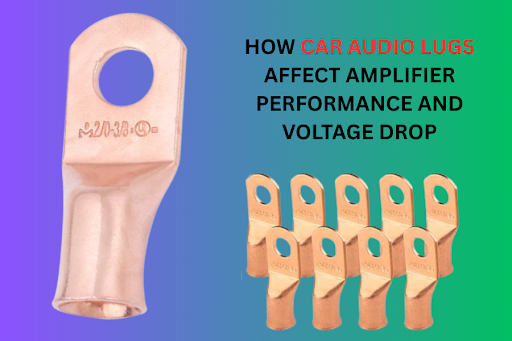When you’re building or upgrading a car audio system, a lot of attention goes to the big-ticket items, amplifiers, speakers, and subwoofers. But hidden behind the panels and under the hood are smaller components that quietly decide how well your system actually performs. Among those unsung heroes are car audio lugs, the connection points that link your power cables to amplifiers, batteries, or distribution blocks.
It might seem like a minor detail, but choosing the right car audio power cable lug has a direct impact on amplifier efficiency, system reliability, and even the sound quality you experience. Let’s break down how these small connectors play a big role in reducing voltage drop and protecting your audio setup.
Why Voltage Drop Matters In Car Audio
Every car audio enthusiast knows that clean power is the basis of clean sound. When voltage drop occurs, you will lose electrical potential as energy travels through power wires and connections. The voltage drop in your power wire determine how much energy will actually get to your amplifiers. Even a small drop in voltage affects the performance of the amplifiers’ capabilities to drive their speakers to their full potential. A voltage drop can deliver sound that is defined as the bass being weak, distortion or inconsistent performance.
A common mistake is assuming that only wire thickness determines voltage drop. While wire gauge is important, the connection points, where wires meet lugs and terminals, are often where resistance builds up. Poor-quality lugs, or ones that aren’t properly installed, create small but significant bottlenecks in the power path.
The Role Of Car Audio Lugs In Power Flow
Think of a car audio lug as a bridge. Its job is to securely transfer current from your power cable to the amplifier or battery. A properly sized and crimped lug ensures maximum surface contact and minimal resistance. But when lugs are undersized, loosely fitted, or made from subpar materials, they increase resistance.
That added resistance doesn’t just reduce efficiency, it generates heat. Over time, overheated lugs can loosen connections, damage terminals, or even pose a safety risk. In car audio systems where amplifiers can pull large amounts of current, reliable lugs are not optional; they’re essential.
How Lugs Affect Amplifier Performance
Your amplifier demands consistent voltage to function at its best. Here’s how car audio lugs influence that performance:
- Stable Power Source: Great quality lugs will hold a strong, low-resistance connection, and therefore ensure the amp gets a steady power supply.
- Less Distortion: The reduction in voltage drop will allow amplifiers to reproduce a clear, undistorted sound, especially at higher power levels.
- Improved Bass Response: While subwoofers are most likely the power-hungry devices that require the most current, with the right lugs the amplifiers can respond quickly without sagging voltage.
- Longevity of Components: Amplifiers operate more effectively when they’re under good voltage conditions, and will reduce wear and provide a longer service life.
Without reliable lugs, even the most advanced amplifier will struggle to reach its full potential.
Choosing The Right Car Audio Lugs
Not all lugs are created equal. Here’s what to consider before making a choice:
- Right Gauge Size: Be certain the lug you are using matches the size of your power cable. For example, if you are using 4 AWG wire, you need a lug that is made for 4 AWG, not a close enough option.
- Material Quality: Copper is the standard material used for audio lugs because of its better conductivity. Stay away from plated or other alloys that skimp on performance.
- Plating Choices: Tinned copper lugs give corrosion protection, which is a great choice if the setup is exposed to moisture or varying conditions.
- Crimping vs. Soldering: Proper installation is just as important as lug selection. Using the right crimping tool ensures maximum contact and secure joints.
- Heat Protection: Putting lugs inside heat shrink tubing creates a tight seal around the lugs which keeps out moisture and protects against damage due to vibration.
Installation Mistakes To Avoid
Even with the best components, improper installation can undo all benefits. Some common mistakes include:
- Using pliers instead of a proper crimping tool, leads to weak connections.
- Choosing oversized or undersized lugs that don’t match the cable gauge.
- Skipping protective covers or tubing, leaving connections exposed to corrosion.
- Not tightening terminal connections can cause voltage drops and intermittent power delivery.
Paying attention to these details ensures your car audio system performs consistently and safely.
Final Thoughts
Car audio people tend to pursue better amps, better subs, or better head units, when in fact the simplest changes yield the most results. Car audio lugs are a small component and often overlooked. The truth is they are the most important link in the power chain. Optimum car audio power cable lugs, if chosen and installed correctly, significantly reduce voltage drop, maximize amplifier performance, and keep your system working properly for the long haul.
If you care about sound quality and reliability, do not let the small parts get overlooked. Check out Selterm’s precision-engineered car audio power cable lugs designed to deliver reliable connections and consistent power flow – because great sound starts with great connectors.

